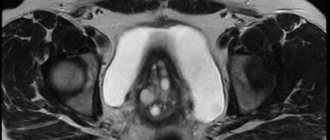What is menopause
Menopause is age-related changes in a woman’s body, the stage of cessation of childbearing function, and the cessation of the menstrual cycle. In other words, a woman in menopause can no longer have children. The period of menopause occurs between the ages of 35 and 65, it all depends on the individual characteristics of the body and hereditary predisposition. The menopause period itself is divided into three stages:
- Premenopause - the cycle is disrupted, menstruation comes intermittently.
- Menopause – Menstruation disappears. Signs of menopause appear.
- Postmenopause - hormonal levels change completely. Natural age-related changes occur. Menopause symptoms disappear. There are no menses.
Menopause is a difficult time for most women. A hormonal imbalance occurs in the body, which causes nervousness, depression, headaches, etc. Hormone replacement therapy helps reduce the negative effects of menopause. Menopause and fibroids can go hand in hand. Often neoplasms and other gynecological tumors progress or regress after menopause.
Diagnosis of the disease
If any disturbances in the functioning of the body occur, you should immediately consult a doctor. If fibroids are suspected, the gynecologist listens to complaints and asks about the characteristics of the menstrual cycle. He finds out whether there is a hereditary factor and learns about the severity of menopause.
Next, an examination takes place on a gynecological chair. It can be used to identify subserous and sumbucous nodes. Of course, if it is small in size it will not be easy to detect, but if it is quite large, it can be identified unambiguously. Material is also collected to identify cancer cells. Hysteroscopy is performed.
The most reliable way to detect nodes is ultrasound. This diagnostic method helps to identify a formation that does not even exceed a few millimeters. Additional studies include Doppler ultrasound.
Taking into account the age of a woman at which these symptoms appear, she may not always suspect that she is developing fibroids. Women in this case often attribute everything to a cycle disorder. But if the disease is detected in time, it can be cured without consequences.
What are uterine fibroids?
Women are often afraid of menopause and fibroids. Few people know what happens when menopause occurs with an intrauterine tumor, and what it actually is. Myoma is a benign nodular tumor in the uterine cavity. It can be very small, up to two centimeters, or huge, from 6-20 centimeters. The types of fibroids depend on where they are located:
- Subserous - located in the outer muscular layers of the reproductive organ, that is, in the area under the peritoneum. The tumor grows towards the pelvis.
- Intermuscular or intramural - located between the muscle layers and grows into the peritoneum. Therefore, with this type of fibroid, the stomach begins to grow.
- Submucosal or submucosal is located under the mucous layer of the uterus.
- Interligamentous or intraligamentous - grows between the uterine ligaments.
The causes of uterine fibroids can be completely different, sometimes there are several factors, sometimes only one. The factors causing this pathology have not been fully studied, but doctors identify several of the most common:
- hormonal imbalance, usually during menopause;
- genetic factor;
- complications after gynecological operations;
- STI;
- bad habits;
- early puberty;
- bad ecology.
All this leads to the formation of myomatous nodes, but most often they appear during menopause or in the premenopausal period.
Uterine fibroids in menopause - what is the risk of node growth
The completion of reproductive processes in the ovaries, which occurs in women aged 45-55 years, leads to menopause. Existing uterine fibroids in menopause gradually regress (decreases in size), but the presence of a benign muscle tumor requires medical supervision in the first years of perimenopause. The onset of menopause is a time of pronounced hormonal fluctuations, against the background of which problems with the uterus may arise. The growth of a myomatous node in the first years of cessation of menstruation is possible, so it is necessary to regularly see a doctor and do an ultrasound scan once every six months. After 3-4 years of menopause, in the absence of negative symptoms, you can be examined once a year.
Symptoms and signs of menopause
Signs of fibroids during menopause may not be noticed if the tumor is small. But, if you try, you can feel the first signs. This:
- Shortening periods between periods and heavy bleeding
- Cycle failure
- Bloody discharge, sometimes heavy, between cycles
- Severe pain during menstruation
- Pain in the lower abdomen, shooting into the lower back
- The belly begins to increase, but the weight does not change
- Difficulty with bowel movements or urination
- Anemia, along with weakness, dizziness, increased fatigue, severe pallor, poor appetite.
Myoma behaves differently during menopause; if it appears during the childbearing period, then during menopause it can resolve or, on the contrary, increase significantly. If it occurs during menopause, it may be asymptomatic or gradually go away.
Is it dangerous and why?
Uterine fibroids during menopause are a common occurrence that most women ignore, especially if the symptoms are not so obvious. But the tumor is not harmless. It can be dangerous to health and even life, despite the fact that it is benign. What dangers does fibroid pose during menopause?
- Anemia. Heavy bleeding can lead to anemia. And this will significantly worsen health, and even pose a danger to life if the disease is advanced.
- Necrosis of fibroids. In other words, nodular necrosis occurs as a result of infectious infection of a node blocking blood flow or other damage. As a result, the tissues die and can cause blood poisoning. Symptoms of necrosis: high fever, bleeding, weakness. The disease can lead to peritonitis or sepsis.
- Twisting the knot. If the knot is supported by a “leg”. If it twists, then nagging pain appears, as during contractions, the stomach hardens, there may be vomiting and severe bleeding.
- Transformation of the tumor. From a benign formation, it can turn into malignant. This is rare, but possible, especially if there is a genetic predisposition. In this case, rapid growth of the tumor, even during menopause, bleeding, purulent discharge with blood.
Therapeutic tactics in perimenopause
Hormonal disorders, typical for the onset of menopause, can provoke the following problems in the female body:
- Changes in apoptosis (reduction of protective factors that prevent tumor growth);
- The emergence of new foci of proliferation in the uterus (endometrial hyperplasia, the appearance of new nodes, the growth of existing leiomyoma);
- General endocrine disorders that have a negative effect on the uterus and ovaries;
- Rare but heavy uterine bleeding, leading to anemia and general weakening of the body.
Uterine fibroids in menopause require treatment, especially during the period of perimenopausal disorders, when rarely occurring critical days against the background of endocrine disorders can provoke an increase in the size of nodes and degeneration of endometrial cells. The basis of treatment tactics is drug therapy: the doctor will prescribe medications that will help you survive the onset of menopause without complications. Indications for surgical removal of the uterus are:
- profuse anemic bleeding that cannot be cured with medications;
- growth of myomatous nodes;
- formation of multiple uterine leiomyomas;
- suspicion of malignant degeneration.
In most cases, surgical intervention can be avoided - with the right approach to the choice of treatment tactics, the woman goes into menopause with the uterus intact.
With the right treatment tactics for uterine fibroids in menopause, there is no need for surgery
Do fibroids grow during menopause?
The reasons for the growth of fibroids during menopause are associated with various factors. The growth of fibroids during menopause can occur during hormone replacement therapy or if the formation is malignant or there are concomitant diseases. For example, endometriosis, myometriosis, ovarian tumors. If fibroids begin to enlarge after menopause, when the level of estrogen in the blood decreases, this may signal the process of degeneration into a cancerous tumor. You can determine that fibroids are growing visually. If the belly grows, but the weight remains unchanged, then this is a growing fibroid.
How to take preventive measures?
Every woman, entering menopause, should take care of her health, regularly undergo ultrasound of the pelvic organs, and examination by a gynecologist. To prevent hormone-dependent pathologies, a doctor may recommend drugs for hormone replacement therapy during menopause.
At this age, you should carefully monitor your diet, avoid gaining excess weight, and consume more fiber in vegetables and fruits. Taking vitamins, regular walks, dosed physical activity, sunbathing are the best means for preventing fibroids during menopause.
It is better to entrust the treatment of fibroids during menopause to a doctor. He will select the necessary therapeutic or surgical method to improve the woman’s well-being and quality of life.
https://youtu.be/DJcTM_AocNE
Dimensions
The size of uterine fibroids during menopause varies. Typically, during menopause, small tumors are more common and do not require treatment. If the fibroids are medium or large in size, they need to be treated even after menopause. Size classification:
- A small formation - up to two centimeters or four weeks by obstetric standards.
- Medium-sized formation - from two to six centimeters or ten to eleven weeks
- Large formation - from six centimeters and above. Weekly from twelve to forty-two.
When selecting treatment, it is necessary to take into account not only the type, but also the size of the tumor.
Diagnosis of fibroids
During the initial visit, the doctor begins the appointment by collecting an anamnesis, is interested in past reproductive diseases, features of the menstrual cycle, symptoms of menopause and manifestations that bother the woman.
Instrumental and laboratory diagnostic methods:
Gynecological examination “in the mirrors”.
Allowing you to visually determine the presence of a submucosal and subserous node.
Biopsy.
Collection of material for histological examination for cancer.
Hysteroscopy.
The procedure for examining the inner surface of the uterus using a hysteroscope is performed under intravenous anesthesia.
Ultrasound of the uterus (intravaginal).
Allows you to detect even small formations.
Ultrasound with Dopplerography.
Study of blood flow in the vessels of fibroids.
A doctor may prescribe hormonal levels for women undergoing menopause by taking a blood test. Based on the data from all studies, a diagnosis is made and the size of the uterine fibroids is recorded.
Treatment methods
Treatment of fibroids during menopause can be either conservative or surgical. You should not ignore the tumor and treat it yourself or wait until it resolves on its own. It may grow so large that it disrupts the functioning of other body systems, or it may have to be cut out along with the uterus. Treatment methods for small benign tumors are most often conservative. If the tumor is large or there is a risk of degeneration, it is removed surgically. Therefore, the earlier treatment is started, the less likely it is to undergo surgical treatment.
Drug treatment
Usually, if a woman has begun menopause and the fibroids are very small, then therapy is not prescribed. Fibroids may regress due to decreased estrogen levels. When is drug treatment recommended:
- nodular formations with a diameter of up to two and a half centimeters;
- intramural or submucosal fibroids;
- the reproductive organ is not greatly enlarged;
- no complications;
- there are no diseases of nearby organs;
- the tumor grows slowly;
- there are no contraindications to taking medications.
The drugs prescribed by gynecologists for fibroids during menopause are aimed at reducing the tumor and suppressing symptoms. If the fibroids are very small, then medications are prescribed to reduce symptoms. Hormonal drugs are prescribed if fibroids are from one to two and a half centimeters. Conservative treatment is prescribed for:
- inhibition of fibroid growth;
- tumor reduction;
- stopping bleeding;
- to relieve the symptoms of uterine fibroids.
The tumor can be reduced by progestogen hormonal agents. For example, Norkodut and Medroxyprogesterone drugs. The course of treatment during menopause is from six months to two to three years. To reduce the effect of pituitary hormones, gonadral antagonists are prescribed - Burselin Depot and others. This way you can stop the tumor from growing.
Is surgery necessary?
It is necessary to operate on the fibroid, whether or not menopause has occurred is decided by the doctor. It all depends on the size of the tumor and its development. For small ones, surgery on fibroids is not necessary. It is enough to regularly visit a gynecologist for diagnosis. But if it is multiple or more than six centimeters, there is bleeding and the risk of degeneration into sarcoma, the fibroid must be removed surgically.
Surgical intervention - types
Surgery is a quick and effective method of getting rid of myomatous tumors. There are several types of surgical intervention. Complete removal of the tumor and uterus - hysterectomy. Removal of fibroids only while preserving the reproductive organs is myomectomy. It is divided into three types:
- Abdominal – when there are no more than three or four formations.
- Laparoscopic – performed to remove subperitoneal and intermuscular fibroids.
- Hysteroscopy – removal of submucosal tumors.
If the tumor is in an advanced state, large in size or there are many of them, there is a risk of migration (degeneration into cancer), then removal of the tumor with the uterus is indicated. A hysterectomy is done either minimally invasively through punctures in the abdomen (laparoscopy) or through an open incision in the abdomen.
Surgery
Surgery is used if:
- there is uterine bleeding due to fibroids;
- there is pain;
- a woman has diseases of the urinary system and rectum;
- its size is more than 12 weeks;
- the tumor grows rapidly;
- this is a sumbucous fibroid;
- there are other diseases of the genital organs;
- there is no positive reaction to hormone treatment.
During treatment, the formation may be removed along with the uterus, or with its preservation.
https://youtu.be/TZK7-IgJtcY
Regression of fibroids during menopause
Fibroids may regress during menopause if they are small and caused by excess estrogen. In this case, you don’t even need to undergo a course of therapy. Intramural and subserous neoplasms can disappear; the rest require treatment. For what other reasons does a regressing tumor appear:
- Carrying out hormone replacement therapy that suppresses estrogen.
- Poor circulation in the uterine area.
The stages of regression of uterine fibroids during menopause have not yet been fully studied, but as a result of the process, the tumor completely disappears, leaving no traces in the endometrial layer of the uterus.
Is sport allowed and what kind?
Doctors advise limiting heavy physical activity if you have fibroids. Do not lift heavy objects or stress the abdominal muscles. But, there are sports that are allowed and even recommended if the fibroid is small and there is no bleeding.
- Swimming and water aerobics classes. This type of exercise relaxes muscles, stimulates intestinal function, and helps reduce fibroids. It is prohibited to engage in extreme water sports, jumping, and diving.
- Therapeutic gymnastics (physical therapy) These are safe and healthy exercises. They should be done under the supervision of physical therapy therapists. They are selected individually.
- Cardio training. Treadmill, exercise bike. Exercise strengthens the abdominal muscles and uterine musculature.
- Stretching. (yoga, pilates). Acceptable for fibroids up to two and a half centimeters in size
- Yoga and Pilates, which largely consist of stretching, but sports are not recommended for medium-sized tumors on the leg.
Folk remedies
Treatment with folk remedies is quite effective for small tumors. With medium sizes, folk remedies can reduce it. But, if the tumor is large, then it is better not to resort to such methods as a panacea.
- Tincture with aloe and honey. Aloe – 400 gr. honey – 700 gr. Cahors - 700 m. Pass the leaves through a meat grinder, mix with honey and wine. To stir thoroughly. Keep in a dark place for five days. Take 15 grams three times a day half an hour before meals.
- Tincture of Borovaya Uterus. Two heaped tablespoons of dry herb per half liter of vodka or alcohol. Mix thoroughly and leave in a dark place for 15 days. Take drops in the morning, afternoon and evening an hour before meals. You can drink it with water.
- Treatment with kerosene. Make twelve cotton swabs. For every day of treatment. The tampon needs to be well moistened in kerosene, squeezed out so that the liquid does not drain and insert
- Tampons with bergenia. Pour two tablespoons of crushed bergenia roots into one and a half cups of boiling water. Leave for nine to ten hours. Then strain the liquid and make herbal tampons from the slurry. Do not pour out the liquid. Douche morning and evening with bergenia decoction diluted with half a glass of water (150 ml of water per teaspoon of decoction), and put on a herbal tampon at night. The course of treatment is up to eight weeks.
Before using home remedies, you should always consult your doctor. Otherwise, the consequences may be the opposite, and instead of benefiting you, you will cause harm to your health.







